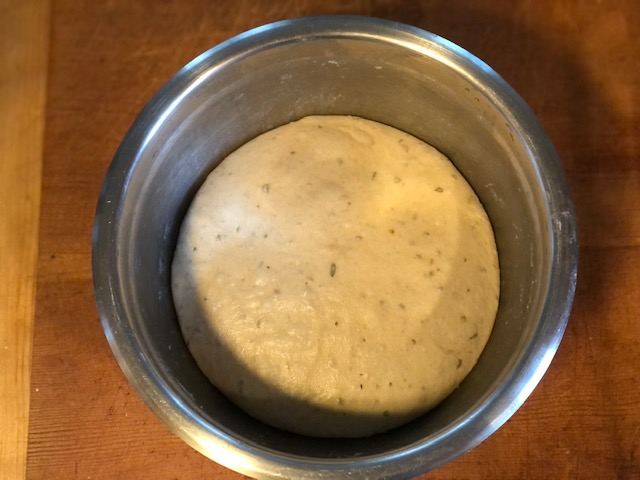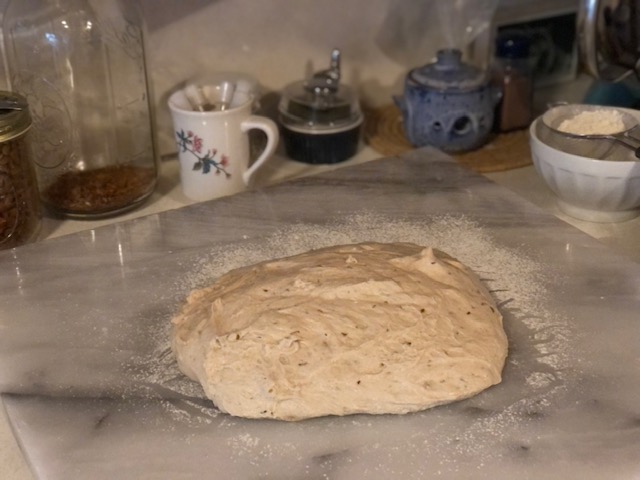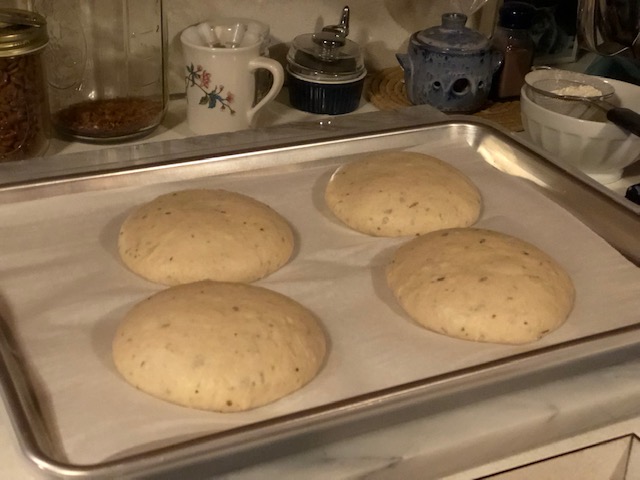
I am getting ready to teach some pie crust workshops in my home… In a lot of ways I’ve been preparing for this for years. Always in the back of my mind I imagine sharing the joy of making a flaky, delicious, all-butter pie crust with everyone I know. I have slowly been collecting equipment.

Getting the table ready!
I’ve been reflecting (read: obsessing) on all the details, and it occurs to me that it might be a good idea to write about my favorite kitchen tools for pie making. So here it goes.

4 quart Pyrex glass bowl (11 3/4″ across the top)
I love this 4 quart Pyrex bowl for mixing pie dough. It is large and shallow; easy to get my hands into. I throw it in the freezer about ten minutes before I want to make my dough; the glass stays cold the entire time I am working, keeping the butter from melting. I can always find one of these at Goodwill.

High quality stainless steel measuring cups and spoons
Maybe I’m spoiled, but I love these measuring cups and spoons. They were given to us as a house warming gift, and they come from Williams-Sonoma. I use them every day for one thing or another, and I love the way they feel in my hand.

KitchenAid pastry blender
I love this KitchenAid pastry blender. The handle is easy on my hands (important!), and I like the red color. I have many pastry blenders (for the workshops!), but my favorite is the KitchenAid. Find one with a soft handle!

Williams-Sonoma spatula
This may seem obvious, but having a good favorite spatula is important! Here’s that red again – so pretty! I also like the wooden handle. I’ve had this one for so long now that the handle is warped, but it’s still the first one I reach for.

OXO brand sifter
I use this sifter all the time for pie and bread making. It makes a nice dusting of flour when I need it. It is always on my counter at the ready. If you are in Seattle, you can get one of these at Cookin’ at Madison Park.

Plastic Wrap Dispenser
For the record, I really don’t like plastic wrap, but I still have to use it every now and then, and especially for wrapping discs of pie dough. In the past I have struggled and wrangled with the kind of plastic wrap you get at the grocery store, but never again. This awesome dispenser you can get at the King Arthur Baking website, along with refills for plastic wrap. It works like a charm. Because I am not wasting the wrap by tearing it in the wrong place, etc, I only use what I need, and no more swearing and gnashing of teeth.

My favorite rolling pin
This is my absolute favorite rolling pin. It is heavy duty, and the chrome handles have a….. wait for it….. RED accent stripe. This rolling pin is vintage and belonged to my mom. I love it. A good rolling pin is heavy, but not too heavy, and rolls smoothly and easily. Check your local thrift stores, but be patient. Don’t get a lightweight one. A good one is worth waiting for.

My other favorite rolling pin
This beautiful, versatile rolling pin is nice and long; perfect for rolling out larger doughs, while still being a good option for pie crust. I got this from Home Cake Decorating in Seattle. This store is a local gem, serving Seattle bakers since 1960. The new owner, Dave, is always there, ready to answer all of your baking questions. Don’t miss any opportunity to drop by and browse. I bet you won’t leave empty handed.

Bench scraper
It may seem strange for me to have a strong opinion about bench scrapers, but I do. This is my very favorite one, made by Progressive. I actually have two of these, since I use them so often. They are great for maneuvering pie dough, scooping up chopped fruit or veggies, and even doing clean up. The Progressive brand has a slightly sharp edge to it, making it my first choice for cubing cold butter. I got mine at our local Maple Leaf Ace Hardware in Seattle.

9″ USA Pan pie pan
Although I have a ridiculous number of pie pans, my 9″ USA Pan pie pans are the ones I prefer. The metal transfers heat quickly, making for a solid bake and crispy crust. If you prefer a decorative ceramic pie plate, you can always bake in the metal pie pan, and then once cooled, slide the pie into your decorative pie plate. You can get these from the King Arthur Baking catalog or website. Warning: deep dish pie plates, although pretty, really cause problems with baking pies. Stick with the shallow ones for best results.

Pastry cutter is behind, pizza wheel in front
If you are just wanting to trim away excess pie dough, a sharp pizza wheel works nicely. I got mine at a thrift shop. For doing more detailed work, or for a fancy fluted edge, you might want an actual pastry cutter. I got mine at Cookin’ at Madison Park. Actually, I should say that my husband and kids got it there; my Christmas wish list is usually all kitchen tools… surprise! In the absence of a pastry cutter, a sharp knife will do.

Pastry brushes – OXO silicone pastry brush in front, bristle brush behind
I never thought I would like a silicone pastry brush, but now I can’t live without one. I use it to brush cream or milk onto pastries and pies before baking, to brush egg wash on breads and rolls before they go into the oven, brush toast with olive oil before topping with other goodies…. and this brush goes in the dishwasher! So you might want to know what I use the bristle brush for? I use it to brush away excess flour from pie dough before it goes into the pie pan; for this job, only a bristle brush will do. I also have a second bristle brush that is reserved for seasoning my pizzelle iron :). I get the bristle brushes from the grocery store, and the OXO silicone brush came from the beloved Mrs. Cook’s that graced the University Village in Seattle for 42 years before closing their doors. I’m not sure where you can get these brushes now, but I would recommend the OXO brand.

The picture says it all
I used to struggle to make the perfect little ring of foil to protect the edges of my pie crusts from burning. It was always so tricky to get the foil just right so that it fit properly, and also so that it didn’t touch the filling and get stuck. This pie crust shield is a life saver! I just plop it on the crust as soon as the edges are golden brown, and then let the pie finish baking. Perfection. Easy to clean and store. Pretty sure I’ve seen these at Home Cake Decorating as well as Cookin’ at Madison Park.

Oven thermometer!
I think everyone should have an oven thermometer. Mine lives permanently in my oven. All ovens are not created equal… some run hot, some run cold; why take any chances? Your masterpieces will bake up beautifully at the right temperature, so better safe than sorry. You can usually find these at the grocery store in the baking section. I got this particular one at a yard sale, and I’m rather obsessed with it, as it is easy to read, and hasn’t discolored like some others I have had. Apparently you can get this at Sur La Table.

Kitchen scale!
I never used to weigh my ingredients, but I also never had consistent results when it came to pie crust. Now I weigh my flour every time! My kitchen scale was given to me by my lovely neighbor Susy, and I cherish it. It hangs on my kitchen wall sometimes, but most of the time it is sitting on my kitchen counter because it gets used so often. If you don’t have a kitchen scale yet, I highly recommend it! You can get the flat, slim kind that stores easily in a kitchen drawer. Although I don’t have a specific one to recommend, I do suggest getting a good one (read all the reviews), because you don’t want to end up frustrated with a model that doesn’t work well. Mine is a Soehnle, and I know that they do still make kitchen scales, including the flat kind. Let me know if you have one that you love!

Citrus Juicer
And because I often use freshly squeezed lemon juice for my apple pies and galettes, among other things, I must recommend this stainless steel citrus juicer made by Endurance. I love that it has a strainer, that the top comes off for easy pouring, and that it goes in the dishwasher for easy cleaning. My glass one got chipped in my gadget drawer, so I had to replace it. I didn’t know I could love a juicer until I owned this one. I got it at Cookin’ at Madison Park.

How could I not mention my marble pastry board?
My marble pastry board has a permanent place of honor in the corner of my kitchen where I spend so much time. This is definitely a luxury; I did fine before I had it, but oh, how I love it. I use it for kneading, cutting, and shaping breads, and of course, for rolling out doughs of all kinds; pie dough, croissant dough, kouign amann dough, cinnamon roll dough… you name it. The marble stays cool, which is a huge bonus when rolling out any pastry dough, since you don’t want the butter to get warm. This one is 18″ x 18″, which is pretty much perfect for all of my kitchen projects. It has some dings and chips on the edges where things have knocked into it, but it is still my sturdy workhorse. This one came from Mrs. Cook’s, but you can most likely find them at fancier kitchen stores. Also, keep an eye out when you go thrifting. Like I said, this is a luxury, not a necessity, but it sure has made my pie life a whole lot easier.
If you are still reading at this point, wow. There were lots of things to write about. Hopefully most of these things are standard kitchen items, and I hope the list is helpful. Happy Pie Making!!!








































































































































